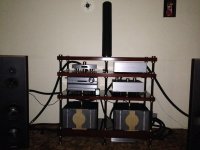On the A1, I upsampled RBCD to 176.4 kHz and lately DSD, believing that it would be better, especially since the Lumin is supposed to be better at DSD.
Recently, I began to notice a slight lack of involvement to the sound. Out of curiosity, I selected native output.
The result was surprising. I kept switching between sampling rates because I initially could not understand what I had heard.
On the Proprius "Now the Green Blade Riseth" album, the male chorus had more "richness" and texture, the flute trill sound was more defined and decay into the hall was more sustained (less so with DSD upsampling, where the decay was slightly truncated).
On Annie Lennox's "A Whiter Shade of Pale", the opening bass lines had more punch and texture. Instrumental lines were more distinct and easier to follow. Plus, the decay of sounds into silence was more sustained.
Overall, music was more involving or exciting, for me, without upsampling. Upsampling to DSD resulted in a smoother sound but something appeared to have been "lost" or thumbed down in the process.
Could be system and music/recording dependent though, and it is not fun to repeatedly listen to the same piece repeatedly with different sampling rates. For now, I am sticking to native output but will continue to experiment.

